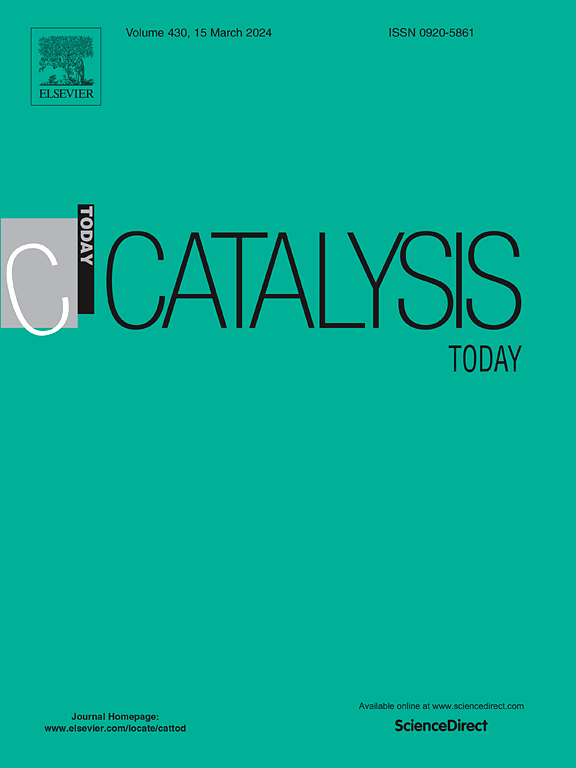沸石载铂催化热解MDF废弃物的研究
IF 5.2
2区 化学
Q1 CHEMISTRY, APPLIED
引用次数: 0
摘要
对清洁能源和环境保护的需求日益增长,促使人们寻求新的技术,以尽量减少过度消耗化石燃料的影响。催化热解因其灵活性、低成本和简单性而成为从生物质中生产能源和化学品的一种有前途的替代途径。然而,这一过程仍然需要为每种应用量身定制的活性催化剂。基于这一目标,本研究在预处理中密度纤维(MDF)残渣的快速热解过程中,对不同SAR(30、60和90)的β沸石负载铂(1 %)催化剂进行了评价。利用从热电厂煤灰中提取的二氧化硅制备了β沸石。Non-oxygenated化合物,比如BTEX(苯、甲苯、乙苯和二甲苯),其他单芳(21.2 - -26.5 %)、萘衍生物(5 - 29.2 %),聚芳(0 - 6.1 %)和线性烃(0.4 - -11.9 %),以及含氧(1.0 - -11.8 %),在催化剂生产与含氧碳氢化合物(80.2 %)和线性(6.6 %)形成的催化剂。催化剂的加入改变了产物的分布,其数量随合成孔径和铂的不同而不同。SAR为30和60的含铂催化剂生成的BTEX含量最高(分别为41.1和42.0 %),是产物中最有价值的化合物,生成的多芳烃含量可忽略不计(0.3 %),是焦炭的主要前体。它们也产生少量的氧合物(5.3:SAR 30和1.4 %:SAR 60)。在BTEX化合物中,含sar30的催化剂比含sar60的催化剂产生更多的苯、甲苯和二甲苯,从而产生更多的乙苯。SAR为90的催化剂对BTEX的选择性最低。这项工作表明,在β沸石(SAR 30和60)上负载铂是MDF快速热解生产BTEX的有希望的选择,具有定制催化剂的优势,可以获得高收率的苯、甲苯、二甲苯和乙苯。此外,该工艺使用了两种残留物(中密度纤维板和煤灰),有利于环境保护。本文章由计算机程序翻译,如有差异,请以英文原文为准。
Catalytic pyrolysis of MDF wastes over beta zeolite-supported platinum
The increasing demand for clean energy and for the environmental protection has driven the search for new technologies that minimize the impacts of the excessive consumption of fossil fuel. Catalytic pyrolysis emerges as a promising alternative route for producing energy and chemicals from biomass, because of its flexibility, low cost and simplicity. However, the process still requires active catalysts that can be tailored for each application. With this goal in mind, catalysts based on platinum (1 %) supported on beta zeolite with different SAR (30, 60 and 90) were evaluated in the fast pyrolysis of pre-treated medium density fiber (MDF) residues in this work. Beta zeolite was prepared using silica extracted from coal ash came from a thermoelectric plant. Non-oxygenated compounds, such as BTEX (benzene, toluene, ethylbenzene and xylenes), other monoaromatics (21.2–26.5 %), naphthalene derivatives (5–29.2 %), polyaromatics (0–6.1 %) and linear hydrocarbon (0.4–11.9 %), as well as oxygenates (1.0–11.8 %), were produced over the catalysts in contrast with oxygenates (80.2 %) and linear hydrocarbons (6.6 %) formed without any catalyst. The catalysts changed the products distribution, the amount varying according to SAR and platinum. The platinum-containing catalysts with SAR 30 and 60 produced the highest amount of BTEX (41.1 and 42.0 %, respectively), the most valuable compounds among the products and formed negligible amounts of polyaromatics (0.3 %), the main coke precursor. They also produced low amounts of oxygenates (5.3: SAR 30 and 1.4 %: SAR 60). Among the BTEX compounds, the catalyst with SAR 30 produced more benzene, toluene and xylenes than that with SAR 60 which in turn formed more ethylbenzene. The catalyst with SAR 90 was the least selective to BTEX. This work showed that platinum supported on beta zeolites (SAR 30 and 60) are promising options to produce BTEX from MDF fast pyrolysis, with the advantage of tailoring the catalysts to obtain high yields of benzene, toluene, xylenes and ethylbenzene. Moreover, the process used two kinds of residues (MDF and coal ash), contributing to environmental protection.
求助全文
通过发布文献求助,成功后即可免费获取论文全文。
去求助
来源期刊

Catalysis Today
化学-工程:化工
CiteScore
11.50
自引率
3.80%
发文量
573
审稿时长
2.9 months
期刊介绍:
Catalysis Today focuses on the rapid publication of original invited papers devoted to currently important topics in catalysis and related subjects. The journal only publishes special issues (Proposing a Catalysis Today Special Issue), each of which is supervised by Guest Editors who recruit individual papers and oversee the peer review process. Catalysis Today offers researchers in the field of catalysis in-depth overviews of topical issues.
Both fundamental and applied aspects of catalysis are covered. Subjects such as catalysis of immobilized organometallic and biocatalytic systems are welcome. Subjects related to catalysis such as experimental techniques, adsorption, process technology, synthesis, in situ characterization, computational, theoretical modeling, imaging and others are included if there is a clear relationship to catalysis.
 求助内容:
求助内容: 应助结果提醒方式:
应助结果提醒方式:


